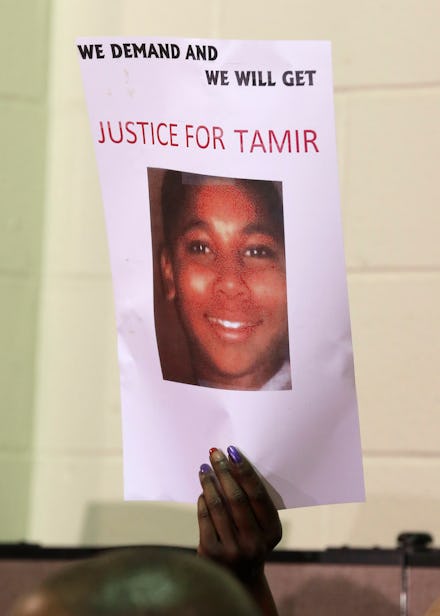Cleveland wanted to demolish the gazebo where Tamir Rice was killed — now it's a memorial

Samaria Rice buried her 12-year-old son Tamir Rice nearly five years ago, after he was shot and killed by police officers in November 2014, in a Cleveland, Ohio park. The moments that would ultimately end her son's life were recorded on CCTV footage, where you can see his body fall in the gazebo where he had been playing. That gazebo, the one where Tamir was murdered, was at risk of disappearing, steadily decaying every day from disrepair — but now it's found a second life as a memorial at a public arts center in Chicago.
The slow destruction of that gazebo could be viewed as a metaphor for the aftermath of Tamir Rice's death. There was never justice served for his killing, and his name has joined the legions of other unarmed black Americans killed by law enforcement. To prevent a total erasure of his memory, Tamir's mother found a way to ensure the gazebo serves as a place for reflection and joy — without the city of Cleveland's help.
Despite Samaria Rice's pleas to Cleveland officials to preserve the gazebo, the city made no such effort — planning to tear it down instead. So in 2016, she partnered with the Rebuild Foundation, an organization founded by artist Theaster Gates, that works to bring art, cultural development, and neighborhood transformation to Chicago communities. The foundation took possession of the gazebo and moved its materials, including memorials left there after Tamir's death, to Illinois. This spring they reconstructed the gazebo at a community arts center owned by the foundation on the South Side of Chicago and it was unveiled for public engagement on June 23, two days before Tamir's birthday, June 25, when he would have turned 17 years old.
"The object of the gazebo is one of incredible historical importance of the black experience in America," Tregg Duerson, the Chief Operating Officer of Rebuild Foundation, told Mic over the phone. "And it's unfortunate and incredibly difficult that we're living in times today where young black men are being taken down by police without a heightened level of police brutality and gun violence."
The gazebo isn't a panacea for Samaria and her fight for justice for her son. The police officers involved in the case were never indicted on any criminal charges related to the shooting. Now, the Cleveland police union is currently trying to reinstate the officer who shot Tamir. Samaria started a petition that has gotten over 170,000 signatures in opposition to the union's lawsuit that seeks to overturn the officer's firing, but it's unclear if that will be enough to prevent his rehiring.
Rather, the gazebo ensures a permanent space for public memory of her son's life. And that is important. Duerson says that preserving the gazebo is vital; it is the only large object that commemorates where an unlawful, racially motivated police shooting occurred. The gazebo in that sense, serves as witness to what happened.
"For the city of Cleveland choice to say well let's tear it down, to hide the memory, or to ensure that the story is not remembered, is the wrong choice," Duerson explains.
"That's not right. It will be best if we can preserve this object as much as we can so that it could be a space where people can reflect and heal and have conversation and a dialogue around race, police brutality, and socioeconomic status."
Samaria Rice and her attorney, Billy Joe Mills — who helped bring the project to fruition — were present at the dedication ceremony on June 23. Mills told the Chicago Sun Times that preservation of the gazebo is also a form of taking back a space marked by the violence of the police officer who shot and killed Tamir Rice.
“A gazebo is a place of sanctuary and peace and play and gathering, and for Tamir Rice, it was that, until these two officers showed up and made it a place of fear and divisiveness and bloodshed,” Mills told the Sun Times. “What we’re doing here today is taking it back, making it the place Tamir originally intended, a place of sanctuary. In that way, it’s something that can be of great healing to Ms. Rice and the Rice family.”